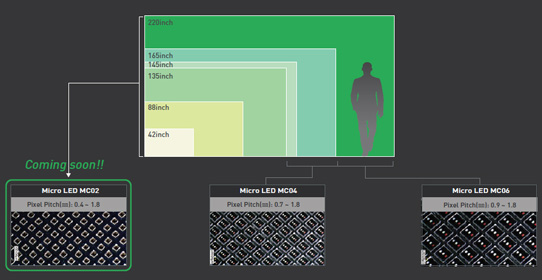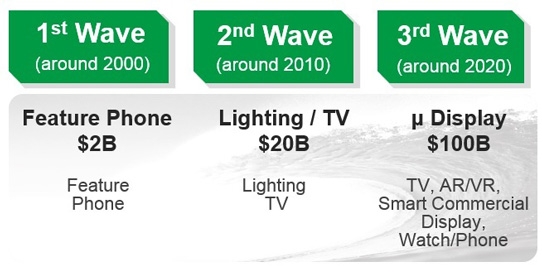News: LEDs
8 January 2020
Seoul Semiconductor and Viosys showcase first 1-pixel µLED enabling 42-220” 4K-resolution TV
At the Consumer Electronics Show (CES 2020) in Las Vegas (7-10 January), South Korean LED maker Seoul Semiconductor Co Ltd has unveiled the new concept display ‘Micro Clean LED’ - developed by its ultraviolet (UV) LED product manufacturing subsidiary Seoul Viosys Co Ltd and ready for mass production - which realizes 4K-resolution TV sizes from 42-inch to 220-inch with one RGB LED per pixel. Also at CES, the Micro Clean LED solutions for a smart watch display is also being demonstrated to main strategic partners by appointment.

The firm says that Seoul Viosys possesses the necessary technologies, from metal-organic chemical vapor deposition (MOCVD) for epitaxial growth of all three colors (RGB) to the transfer of small-sized micron-scale RGB chips. Seoul Semiconductor also possesses the tiling technology and substrate connectivity technology for large-screen displays due to readying surface-mount technology (SMT) manufacturing processes at the customer’s request in its own factory.

Furthermore, since it is developed as 1 pixel, it resolves three main challenges for micro-LEDs, which are the transfer technology, color mixing and the individual color and intensity of light control. By resolving these three challenges, costs can be reduced by a third, it is reckoned. Also, product reliability testing has been completed.
Seoul Semiconductor notes that, in the LED market, the first wave was the adoption of LED technology in mobile phone applications in the 2000s. The second wave was LED TV and lighting applications in the 2010s. As the third wave grows to a $100bn market with LCD and OLED displays, micro-LED are expected to capture a significant portion of the next generation display market. They are also suitable for light sources in the virtual reality/augmented reality (VR/AR) and mixed reality (MR) sectors. The micro-LED is reckoned to be the only light source that can deliver 1000 times faster response times, a 30% reduction in internal and external power consumption, and infinite contrast range compared with existing LCD and OLED displays.







